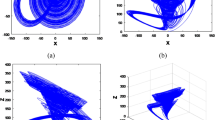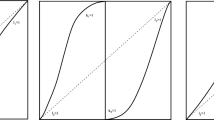Abstract
A natural question of how the survival probability depends upon a position of a hole was seemingly never addressed in the theory of open dynamical systems. We found that this dependency could be very essential. The main results are related to the holes with equal sizes (measure) in the phase space of strongly chaotic maps. Take in each hole a periodic point of minimal period. Then the faster escape occurs through the hole where this minimal period assumes its maximal value. The results are valid for all finite times (starting with the minimal period) which is unusual in dynamical systems theory where typically statements are asymptotic when time tends to infinity. It seems obvious that the bigger the hole is the faster is the escape through that hole. Our results demonstrate that generally it is not true, and that specific features of the dynamics may play a role comparable to the size of the hole.
Similar content being viewed by others
References
V. Afraimovich, Pesin’s dimension for Poincaré recurrences, Chaos 7 (1997), 12–20.
V. Afraimovich, J-R. Chazottes and B. Saussol, Local dimensions for Poincaré recurrences, Electronic Research Announcements of AMS 6 (2000), 64–74.
V. Afraimovich, E. Ugalde and J. Urias, Fractal Dimensions for Poincaré Recurrences, Elsevier Science, Amsterdam, 2006.
E. G. Altmann and T. Tél, Poincaré recurrences from the perspective of transient chaos, Physical Review Letters 17 (2008), 174101–174105.
V. Baladi, C. Bonatti and B. Schmitt, Abnormal escape rates from nonuniformly hyperbolic sets, Ergodic Theory and Dynamical Systems 19 (1999), 1111–1125.
G. E. Bredon, Topology and Geometry, Springer, Berlin, 1993.
H. Bruin, M. Demers and I. Melbourne, Existence and convergence properties of physical measures for certain dynamical systems with holes, Ergodic Theory and Dynamical Systems 3 (2010), 687–728.
H. Buljan and V. Paar, Bursts in the chaotic trajectory lifetimes preceding controlled periodic motion, Physical Review E 62 (2000), 4869–4872.
H. Buljan and V. Paar, Many-hole interaction and average lifetimes of chaotic transients that precede controlled periodic motion, Physical Review E 63 (2001), 066205–066218.
I. Cakir, O. Chryssaphinou and M. Månsson, On a conjecture by Eriksson concerning overlap in strings, Combinatorics, Probability and Computing 8 (1999), 429–440.
N. Chernov and R. Markarian, Ergodic properties of Anosov maps with rectangular holes, Boletim da Sociedade Brasileira de Matemática. Nova Série 28 (1997), 271–314.
N. Chernov, R. Markarian and S. Troubetzkoy, Conditionally invariant measures for Anosov maps with small holes, Ergodic Theory and Dynamical Systems 18 (1998), 1049–1073.
N. Chernov, R. Markarian and S. Troubetzkoy, Invariant measures for Anosov maps with small holes, Ergodic Theory and Dynamical Systems 20 (2000), 1007–1044.
P. Collet, S. Martinez and B. Schmitt, The Yorke-Pianigiani measure and the asymptotic law on the limit Cantor set of expanding systems, Nonlinearity 7 (1994), 1437–1443.
M. Demers, Markov extensions and conditionally invariant measures for certain logistic maps with small holes, Ergodic Theory and Dynamical Systems 25 (2005), 1139–1171.
M. Demers, Markov extensions for dynamical systems with holes: an application to expanding maps of the interval, Israel Journal of Mathematics 146 (2005), 189–221.
M. Demers and L.-S. Young, Escape rates and conditionally invariant measures, Nonlinearity 19 (2006), 377–397.
M. J. Erickson, Introduction to Combinatorics, Wiley-Interscience, New York, 1996.
K. Eriksson, Autocorrelation and the enumeration of strings avoiding a fixed string, Combinatorics, Probability and Computing 6 (1997), 45–48.
L. J. Guibas and A. M. Odlyzko, Maximal prefix-synchronized codes, SIAM Journal on Applied Mathematics 35 (1978), 401–418.
L. J. Guibas and A. M. Odlyzko, Periods in strings, Journal of Combinatorial Theory. Series A 30 (1981), 19–42.
L. J. Guibas and A. M. Odlyzko, String overlaps, pattern matching, and nontransitive games, Journal of Combinatorial Theory. Series A 30 (1981), 183–208.
V. Halava, T. Harju and L. Ilie, Periods and binary words, Journal of Combinatorial Theory. Series A 89 (2000), 298–303.
O. Jenkinson, Maximum hitting frequency and fastest mean return time, Nonlinearity 18 (2005), 2305–2321.
A. Katok and B. Hasselblatt, Introduction to the Modern Theory of Dynamical Systems, Cambridge University Press, 1998.
D. Lind, Perturbation of Shifts of Finite Type, SIAM Journal on Discrete Mathematics 2 (1989), 350–365.
D. Lind and B. Marcus, An Introduction to Symbolic Dynamics and Coding, Cambridge University Press, 1995.
C. Liverani and V. Maume-Deschamps, Lasota-Yorke maps with holes: conditionally invariant probability measure and invariant probability measures on the survivor set, Annales de l’Institut Henri Poincaré. Probabilités et Statistiques 39 (2003), 385–412.
M. Lothaire, Applied Combinatorics on Words, Cambridge University Press, 2005.
M. Månsson, Pattern avoidance and overlap in strings, Combinatorics, Probability and Computing 11 (2002), 393–402.
V. Paar and N. Pavin, Discontinuous pattern of cumulative separation between orbits of chaotic transient, Physics Letters. A 235 (1997), 139–144.
V. Paar and N. Pavin, Bursts in average lifetime of transients for chaotic logistic map with a hole, Physical Review E 55 (1997), 4112–4115.
G. Pianigiani and J. Yorke, Expanding maps on sets which are almost invariant: decay and chaos, Transactions of the American Mathematical Society 252 (1979) 351–366.
J. Schneider, T. Tél and Z. Neufeld, Dynamics of “leaking” Hamiltonian systems, Physical Review E 66 (2002), 2181–2186.
H. Van den Bedem and N. Chernov, Expanding maps of interval with holes, Ergodic Theory and Dynamical Systems 22 (2002), 637–654.
P. Walters, An Introduction to Ergodic Theory, Springer, Berlin, 1982.
Author information
Authors and Affiliations
Corresponding author
Rights and permissions
About this article
Cite this article
Bunimovich, L.A., Yurchenko, A. Where to place a hole to achieve a maximal escape rate. Isr. J. Math. 182, 229–252 (2011). https://doi.org/10.1007/s11856-011-0030-8
Received:
Revised:
Published:
Issue Date:
DOI: https://doi.org/10.1007/s11856-011-0030-8




